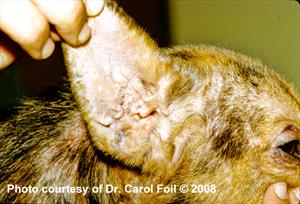Severe chronic atopic otitis.

This dog has had a lateral ear canal resection, but the symptoms of severe AD have compromised management of otitis externa. Courtesy of Dr. Carol Foil.
What is Malassezia otitis?
Malassezia spp. are a common secondary cause of otitis or inflammation of the ear canal. It is a yeast that normally lives in the ears of cats and dogs but overgrows when the environment of the ear canal changes. This change is a result of increased fatty secretions and moisture, making it easier for the Malassezia to multiply. Some primary, or underlying, causes of ear infection include allergies (atopic dermatitis or food hypersensitivity) and narrowed ear canals. Studies have shown that bacteria can be found in combination with a Malassezia otitis.
Who gets it?
Malassezia ear infection is common in dogs, but cats can also be infected. Dogs with narrow ear canals or increased ear secretions create the perfect environment for yeast overgrowth. There is no specific age group or sex this infection targets.
What are the signs?
Many of these signs are similar to those from other types of ear infection. Therefore, the veterinarian will have to complete diagnostic tests to prove there is yeast overgrowth. Signs of ear infections include:
- Increased ear wax and discharge
- Odor
- Head shaking
- Swollen or ulcerated ear flap
- Hair loss on ears
- Increased pigmentation of ears
- Aural hematomas (collection of blood under the skin of the ear)
- Itchy
- Painful
- Loss of hearing
How is Malassezia otitis diagnosed?
A veterinarian’s exam of the ear canal may show ulcerations, redness, swelling, dark brown waxy discharge, a musty odor, or masses. If your pet is in pain, sedation or general anesthesia may be needed for your pet’s veterinarian to complete a full exam of the ear.
Cytology is an important part of diagnosing Malassezia otitis. The veterinarian will swab some debris out of the ear canal to view with a microscope. If your pet has a Malassezia ear infection, your veterinarian may see a greater than normal amount of yeast.
How is Malassezia otitis treated and prevented?
- Cleaning the ear at home to remove excess debris that prevents medication from working. (With some medications cleaning will not be advised or may be unnecessary, so follow your veterinarian's instructions specific to your pet.)
- Topical antifungals to treat the yeast infection.
Therapy length varies and your veterinarian determines if treatment may be stopped during the re-check appointment.
Without addressing the underlying, or primary, cause of the Malassezia otitis, the ear infection will return when the medication is stopped. Repeated ear infections can lead to a deeper ear infection and long-term use of some medications can cause side-effects. Your veterinarian can work with you to find and treat the primary cause of Malassezia otitis. Determining why your pet develops ear infections will help prevent future ear infections and reduce the need for ear medications.